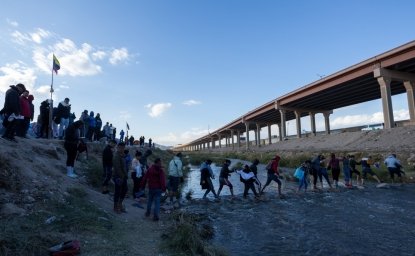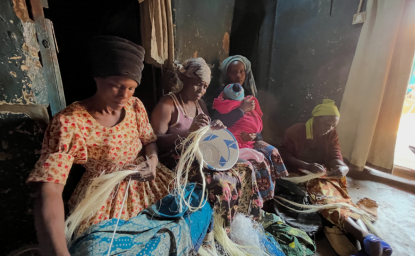The United States and Mexico escaped President Trump’s threat of mutually destructive tariffs with a June 7 agreement on steps to reduce migrant flows to the United States. Mexico since has dramatically improved its efforts to reduce the number of Central American and other migrants reaching the U.S.-Mexico border.
The number of migrants apprehended at the U.S. border reportedly dropped to under 100,000 in June from 144,000 in May, a reduction of over 30 percent. Mexico deported 22,000 migrants in June, a 33 percent increase from May and a 13-year high.
The Mexican government moved boldly to implement the agreement, bolstering its migration agency and diverting security forces to address migration rather than serious violent crime. U.S. and Mexican officials are working more closely than before.
Major problems remain. Both governments need to deepen and expand plans for managing the migrant flows and addressing the humanitarian and political crises of Central American migration.
Sharp debates continue in both countries over how to humanely handle the migrants, how to build the capacity to do that, and how to forge a regional approach that deals with the factors pushing migrants to migrate and poor practices in other countries.
U.S. headlines reveal the divisions over U.S. immigration policies and treatment of migrants and asylum seekers in the U.S. Mexico also is experiencing division, with many criticizing the government for the agreement. The migrant surge and U.S. pressure is making Mexico face up to its role as a major transit country to the U.S, its lack of a well-defined migration policy, and its woefully weak, underfunded and corruption-prone systems for handling migrants. The "crisis" gives Mexico the opportunity to make needed improvements.
Public security is of great concern, since Mexico is drawing from newly formed National Guard to help reduce migrant flows, even while the government is struggling to reduce widespread crime, which is supposed to be the National Guard’s main task. Recent polls give President Lopez Obrador, popularly referred to as AMLO, low marks on handling crime, one year after his election.
AMLO still gets positive overall poll ratings above 60 percent, however. Mexicans increasingly are negative about Central American migrants and the burdens they generate, with big majorities polled recently favoring stronger enforcement and deportation. Polls also show mistrust that President Trump will respect agreements with Mexico.
AMLO appointed a new head of Mexico’s migration service who promises to correct the poorly handled efforts since December and is increasing the number of migration officers. Mexico surpassed its promises to send 6,500 National Guard to its southern border, deploying over 20,000 security forces including near the U.S. border. The objective, Mexican officials explain, is to channel migrants into a regularized migration system.
Mexico also has started to freeze assets of migrant smugglers and has announced investigations into human trafficking networks, even if officials are found to be involved. Mexico is working with the United Nations High Commissioner for Refugees (UNHCR) and the International Organization for Migration (IOM) to help strengthen its migration and asylum systems. Mexican authorities are considering temporary work permits for migrants in Northern Mexico while they await U.S. asylum decisions. U.S. and Mexican officials are communicating day to day to share information and work through the paths ahead.
The challenges remain enormous. On both sides of the border, respect for human rights and civil liberties are serious concerns, as are overcrowded facilities and overworked officials. The U.S. has yet to speed up its asylum adjudication process. The U.S. continues to seek “safe third country” agreements with Mexico and others, whereby individuals would need to apply for asylum in the first country they enter upon leaving their home country, e.g. Mexico or Guatemala. But other governments and migration experts are skeptical. Many are for developing a regional set of mutual obligations regarding migrants and improving U.S. asylum processing.
The recently approved additional U.S. funds to better care for migrants and to speed up the overloaded U.S. system for handling migrant asylum claims are welcome, but many maintain that the U.S. also needs to address medium- and longer-term sources of the migrant flows, with targeted assistance to areas generating migrants to reduce the pressures pushing people to leave.
Mexican officials argue strongly for investments to generate jobs for potential migrants in their home countries and in southern Mexico. They are trying to rally U.S. and other international support, but most U.S. aid to Central America remains suspended or has been redistributed elsewhere. Earlier U.S. pledges to support substantial private investment in southern Mexico have not yet produced results, nor is it clear that the U.S. will offer new funds essential for strengthening Mexican and Central American migration and enforcement capacities. The U.S. also has not yet joined Mexico in sanctioning those involved in migrant smuggling.
This signals a full agenda for the months ahead. The U.S. and Mexico agreed to 45-day and 90-day reviews under their agreement. Informed officials say privately that enhanced Mexican enforcement, combined with U.S. efforts, should be able to deliver further reductions in migrant numbers. Some U.S. officials think the number reaching the U.S. border could go down to 70,000 per month, or less, with energetic Mexican implementation.
Sustaining and surpassing such levels will be problematic, however. It would require diverting more officials from fighting violent crime and drug trafficking, for example. Mexico’s institutions need substantial capacity-building and additional funding, as do Central American authorities. Additionally, the U.S. and Mexico need meaningful commitments from regional countries to reduce migration.
U.S. and Mexican authorities should engage systematically now to pursue solutions to make progress sustainable, as well as on the fight against organized crime, which is a severe problem that intersects migrant issues at the borders as well as in the domestic priorities of both countries.
Neither the U.S. nor Mexico will benefit from a return to threats of costly trade tariffs over migration or crime. They have the opportunity to build on progress to develop a much more coordinated and effective effort to deal with Central American migration. The way ahead demands sustained U.S.-Mexico engagement, including at the cabinet level, to forge solutions together.
Author

Former Career Ambassador to Afghanistan, Argentina, and Mexico; Distinguished Diplomat in Residence, School of International Service, American University

Mexico Institute
The Mexico Institute seeks to improve understanding, communication, and cooperation between Mexico and the United States by promoting original research, encouraging public discussion, and proposing policy options for enhancing the bilateral relationship. A binational Advisory Board, chaired by Luis Téllez and Earl Anthony Wayne, oversees the work of the Mexico Institute. Read more





